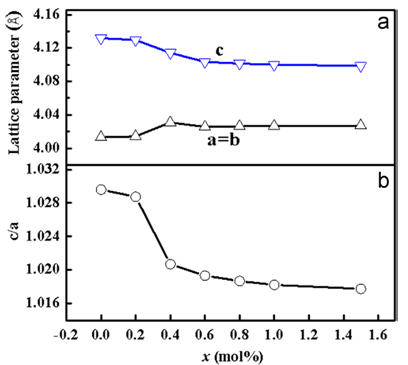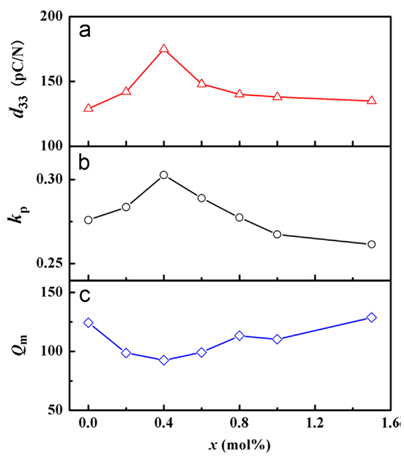Piezoelectric ceramics with a working temperature higher than that of the conventional Pb(Zr,Ti)O3 (PZT) have recently attracted increasing attention. High Tc and high piezoelectric response were recently achieved for a new perovskite type system BiScO3-PbTiO3 (BSPT). However, the very low mechanical quality factor (Qm) of BSPT and the high cost of Sc seriously limits its application, particularly, for high power devices.
Therefore, low cost complex perovskite high temperature piezoelectric ceramics with a higher Qm are key factors for limiting its application. BiYbO3-PbTiO3 (BYPT) has a high Tc and a considerable piezoelectricity. However, its overall electric performance is still poor. In addition, the effect of doping elements on the structure and performance of this system is still rarely studied.
Researchers from the Institute of Acoustics, Chinese Academy of Sciences select a hard doping element Fe as a dopant, and also investigate the phase structure and electrical properties of BiYbO3-Pb(Zr,Ti)O3+x(mol%) Fe2O3 (BY-PZT-xFe) piezoelectric ceramics with a special emphasis on the influence of Fe2O3 content.
Research results reveal that all ceramics have a perovskite main phase with a tetragonal symmetry. The partial substitution of Fe3+ with Zr4+ and Ti4+ in the B-site cause a shrinkage of the perovskite lattice and a decreased tetragonality (c/a) with increasing x up to the solid solubility saturation at x=0.4 (see Fig. 1). A lower tetragonality c/a, better grain morphology, and higher density as well as limited impurity phase are achieved at x=0.4 composition, all of which contribute to the improved piezoelectric properties. The BY-PZT-xFe ceramics show a high Curie temperature Tc around 400℃ and good piezoelectric properties with d33 reaching 175pC/Nat x=0.4 (see Fig. 2).

Fig. 1 Lattice parameters (a) and c/a (b) of the BY-PZT-xFe ceramics (Image by GUO Dong).

Fig. 2 Piezoelectric constant d33(a), planar electromechanical coupling factor kp(b), and mechanical quality factor Qm(c) of the BY–PZT–xFe ceramics (Image by GUO Dong).
This research was supported by the “100 Talented Program” of Chinese Academy of Sciences, the National Key Basic Research Program of China (973 Program, Grant no. 2013CB632900) and the National Science Foundation of China (NSFC No. 11074277). It was also supported by the open foundation of the state key laboratory of new ceramics and fine processing of Tsinghua University.
References:
SHI LIANG, ZHANG Boping, LIAO Qingwei, ZHU Lifeng, ZHAO Lei, ZHANG Daibing, GUO Dong. Piezoelectric Properties of Fe2O3 Doped BiYbO3-Pb(Zr,Ti)O3 High Curie Temperature Ceramics. Ceramics International (vol. 40, no. 8, part A, pp. 11485–11491, September 2014). DOI: 10.1016/j.ceramint.2013.10.043
Contact:
GUO Dong
Institute of Acoustics, Chinese Academy of Sciences, 100190 Beijing, China
Email: dong.guo@mail.ioa.ac.cn


